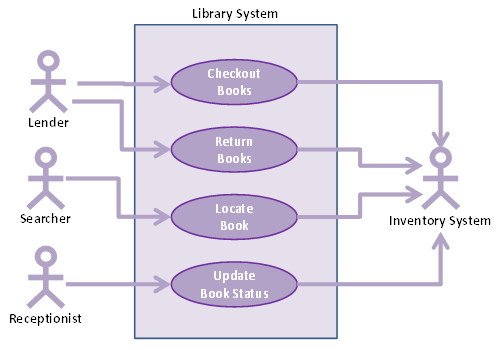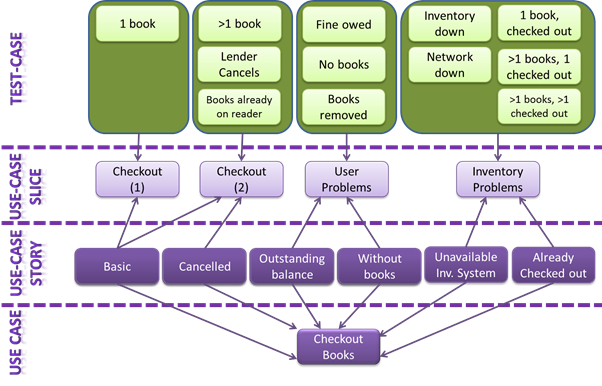When using use-case slices, the process becomes as follows:
- Create the use-case model
- Define initial use cases
- Define use-case stories
- Define use-case slices
- Add more details where needed.
Create the use-case model
- In a use-case modeling session, initial draft is created of the system in terms of use cases. Use cases should focus on value and not on technology or the internal design of the system. I often see people using things like “login” as a use case; that is just plain wrong.

- For real-life system number of use cases will end up in the 4-20 range.
- We can see that there are 3 roles (Actors) that initiate actions within our system from this diagram.
- The Lender may checkout books, or returns books, using “Checkout Books” or “Return Books”. We can find book by using “Locate Book”. At the end Receptionist might make manual changes to the status of a book by using “Update Book Status”. Inventory System never initiates the actions within our system. The all use cases give the actor some value; checking out books has value, like “insert card” or “validate library membership” does not have value on its own, it would not be represented as a use case.
Define initial use cases
- In this step, some high level version of the use case is created (known as a bulleted outline level). For example, I use the Checkout Books use case.
Use Case: Checkout Books
Brief Description
Through this Use Case, Lender is able to check out books from the library through a self-service process.
Basic Flow
- Enter library card
- Indicate the books which need to be checked out
- Put books on reader
- Update the status in the inventory
Alternative Flows
AF1 – Lender cancels
AF2 – Lender had outstanding balance to pay
AF3 – No books on reader
AF4 – Inventory system not available
AF5 – book already checked out
- This is by no means a fully flushed-out use-case narrative; it is enough to get the job done. At this point we do not need to specify it in more detail.
Define use-case stories
- This step is splitting up the use case into the individual ways of getting from the beginning of the use case to the end. Checkout Books use case would be split up as follows:
| Use-case Story | Use Case | Flow(s) |
|---|---|---|
| Checkout Books – basic | Checkout Books | Basic flow |
| Checkout Books – Cancelled | Checkout Books | Basic flow + AF1 |
| Checkout Books - Outstanding balance | Checkout Books | Basic flow + AF2 |
| Checkout Books - Without books | Checkout Books | Basic flow + AF3 |
| Checkout Books - Unavailable inventory system | Checkout Books | Basic flow + AF4 |
| Checkout Books - Already checked-out book | Checkout Books | Basic flow + AF5 |
Define use-case slices
- Now we are almost there, we have the use-case stories, we can start defining the use-case slices. Look at the definition again:
- A use-case slice is a collection of front-to-back flows through a use case, which including the associated test cases that are of clear value to the customer. Front-to-back flow is called a use-case story.
- So we need to come up with a way to combine use-case stories into slices, possibly splitting them up by specifying test cases. Result highly depends on the situation and will be a result of interaction between the Product Owner and the Team. Checkout Books use case, so we might end up with the following use-case slices:
| Use-case slice | Use-case story | Test-case |
|---|---|---|
| Checkout step 1 | Checkout Books – basic | Checkout one book |
| Checkout step 2 | Checkout Books – basic | Checkout multiple booksCheckout with books already on reader |
| Checkout Books – Cancelled | Lender cancels checkout | |
| Checkout user problems | Checkout Books - Outstanding balance | Checkout while user owes fine |
| Checkout Books - without books | Checkout when user did not put books on trayCheckout when user removes books before scan | |
| Checkout inventory problems | Checkout Books -Unavailable inventory system | Checkout when inventory system is downCheckout when network is unavailable |
| Checkout Books - Already checked-out book | Checkout of 1 book (already checked out)Checkout of multiple books (1 checked out)Checkoumultiple books (>1, but possibly not all, checked out) |
All of these use-case slices will then be considered backlog items. Here we are done. And we have created our backlog.
What did we do?
While defining the backlog I took a number of steps. Following picture of our library system shows how everything fits together:

Tutors, at the Assignmentpedia, take pledge to provide full satisfaction and assurance in Use case Slice Diagram homework help via online tutoring. The students are getting 100% satisfaction by online tutors across the globe. Here you can get homework help for Use case Slice Diagram, assignments, homework and project ideas and tutorials. We provide email based Use case Slice Diagram homework. You can join us to ask queries 24x7 with live, qualified and experienced online tutors specialized in Use case Slice Diagram. By the way of Online Tutoring, student would be able to complete your homework or assignments at your home. The tutors at the Assignmentpedia are committed to provide the best quality online tutoring assistance for Use case Slice Diagram homeworkhelp and assignment help services. Tutors use their experience, as they have solved thousands of the Use case Slice Diagram assignments that may help you to solve your complex issues of Use case Slice Diagram with high quality work and no plagiarism. Assignmentpedia assure for the best quality compliance to your homework. Whenever we feel we are not able to provide the Use case Slice Diagram homework help as per the deadline or given instruction by the student, and then we refund the money of the student without any delay.